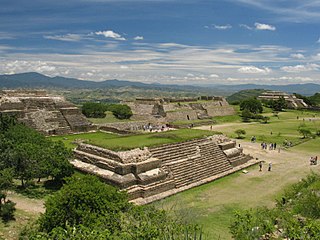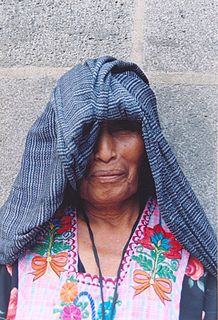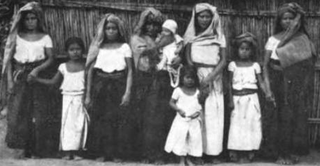
The city and municipality of Oaxaca de Juárez, or simply Oaxaca, is the capital and largest city of the Mexican state of the same name. It is located in the Centro District in the Central Valleys region of the state, on the foothills of the Sierra Madre at the base of the Cerro del Fortín extending to the banks of the Atoyac River. The city relies heavily on tourism, which is based on its large number of colonial-era structures as well as the native Zapotec and Mixtec cultures and archeological sites. It, together with the archeological site of Monte Albán, was named a World Heritage Site in 1987. It is also the home of the month-long cultural festival called the "Guelaguetza", which features Oaxacan dance from the seven regions, music and a beauty pageant for indigenous women.

The Mixtecs, or Mixtecos, are indigenous Mesoamerican peoples of Mexico inhabiting the region known as La Mixteca of Oaxaca and Puebla as well as the state of Guerrero's Región Montañas, and Región Costa Chica, which covers parts of the Mexican states of Oaxaca, Guerrero and Puebla.
Mixtec transnational migration is the phenomenon whereby Mixtec people have migrated between Mexico and the United States, for over three generations.

The Zapotec languages are a group of around 50 closely related indigenous Mesoamerican languages that constitute a main branch of the Oto-Manguean language family and which is spoken by the Zapotec people from the southwestern-central highlands of Mexico. The 2010 Mexican census reports 425,000 speakers, with the majority inhabiting the state of Oaxaca. Zapotec-speaking communities are also found in the neighboring states of Puebla, Veracruz, and Guerrero. Labor migration has also brought a number of native Zapotec speakers to the United States, particularly in California and New Jersey. Most Zapotec-speaking communities are highly bilingual in Spanish.
Migrant literature is either written by migrants or tells the stories of migrants and their migration. It is a topic of growing interest within literary studies since the 1980s. Migrants are people who have left their homes and cultural settings and who started a new life in another setting that is, in most cases, initially strange to them.

The Zapotec civilization was an indigenous pre-Columbian civilization that flourished in the Valley of Oaxaca in Mesoamerica. Archaeological evidence shows that their culture goes back at least 2,500 years. The Zapotec left archaeological evidence at the ancient city of Monte Albán in the form of buildings, ball courts, magnificent tombs and grave goods including finely worked gold jewelry. Monte Albán was one of the first major cities in Mesoamerica and the center of a Zapotec state that dominated much of the territory that today belongs to the Mexican state of Oaxaca.
The Chatinos are an indigenous people of Mexico. Chatino communities are located in the southeastern region of the state of Oaxaca in southern central Mexico. Their native Chatino language is spoken by about 23,000 people, but ethnic Chatinos may number many more. They call themselves qne-a tnya-e and their language Chaq-f tnya-b.
Villa Hidalgo Yalalag is a village in Oaxaca, Mexico. It is located near Villa Alta District in the center of the Sierra Norte Region.

Balmy Alley is a one-block-long alley that is home to the most concentrated collection of murals in the city of San Francisco. It is located in the south central portion of the Inner Mission District between 24th Street and Garfield Square. Since 1973, most buildings on the street have been decorated with a mural.

The Indigenous people of Oaxaca are descendants of the inhabitants of what is now the state of Oaxaca, Mexico who were present before the Spanish invasion. Several cultures flourished in the ancient region of Oaxaca from as far back as 2000 BC, of whom the Zapotecs and Mixtecs were perhaps the most advanced, with complex social organization and sophisticated arts.

The state of Oaxaca, Mexico has a total population of about 3.5 million, with women outnumbering men by 150,000 and about 60% of the population under the age of 30. It is ranked tenth in population in the country. Fifty three percent of the population lives in rural areas. Most of the state’s population growth took place between 1980 and 1990. Life expectancy is 71.7 for men and 77.4 for women, just under the national average. Births far outpace deaths. In 2007, there were 122,579 birth and 19,439 deaths. Approximately 85% profess the Catholic faith.
Transnational Barrios as a concept within Latin American and Latino studies explains the social construction of space, place, culture, traditions, and artistic symbolic meanings that are established beyond national boundaries by diverse Latina/o populations in communities of a hosting country. Therefore Transnational Barrios are seen by scholars as critical spaces to celebrate and embrace cultural production, political mobilizations, ethnic identity and solidarity, and develop a sense of belonging within communities.
Transmigrant is a term, greatly developed by the work of Nina Glick Schiller, which is used to describe mobile subjects that create and sustain multiple social relations that link together their societies of origin and residence. These mobile subjects are now viewed as transnational migrants or transmigrants to distinguish them from migrants and immigrants.
Los Mojarras are a band from the province of El Agustino Lima Peru that formed in 1992. They released their first album in the same year, titled Sarita Colonia, and are still currently producing music and performing. Link label They have been politically active through their music, voicing political realities and views. Their music is referred to as Peruvian rock, however Luis A. Ramos-Garcia, a professor and researcher of Latin American theater and popular music from the University of Minnesota, describes their music as a “mixture of Chicha or Peruvian cumbia, Andean Cumbia, and Afro-Peruvian styling’s”. Their style of music also includes blends of rock music. Critically analyzed, the music of Los Mojarras, can be thought of as a form of transculturation, in which the emergence of mixed cultures are expressed through the mixture of musical rhythms. This type of music can also be described a form of cultural hybridity, in which the music and its scene has become a new cultural production raised out of multiple existing cultures or shared meanings. As Jesus-Martin Barbero, a researcher and philosopher, who’s disciplined in Cultural Studies; has stated “music is the result of mestizaje, the profane deformation of an authentic form.” Link label Appropriated in musical terms, mestizaje can refer to the mixtures of different music produced as a response to the formations of new social identities; and in the search of belonging by new generations of Andean migrants in capital cities. This mixture of music has primarily been played by the “decedents of migrant Andeans, who grew up and/or were born in major cities such as Lima, in Peru”. These migrants come from rural areas in Peru, moving to modernized cities often forced because of economic circumstances, exemplifying a form of local diasporic mobility. Los Mojarras lyrics range from the issues of societal displacement, dislocation of Andean migrants in major cities and working class migrant experiences and issues. Their music genre became recognized as a form of “new musical subjectivity by marginalized Urban-Andeans”, that were expressing for the first time, within chicha music that has primarily been about love or romance; anger, agency, political issues and concerns. Los Mojarras created a space for people living within the marginalized sectors of Peru. These artists also brought “ attention to the problems situated within the hegemonic Creole-Spanish model maintained by privileged classes”, and narrating through music the conflicts between Limeños and Andean migrants, that arise within the city of Lima.

Lourdes Gutierrez Najera is an American cultural anthropologist. She is an assistant professor in the Department of Anthropology at Drake University. She is a member of the Latin American Studies Association, American Anthropological Association, and Mujeres Activas en Letras y Cambio Social. Her research is published in journals and books such as Beyond El Barrio: Everyday Life in Latina/o America. Other publications include reviews of scholarly work. Her academic accomplishments and research pertain to the field of Latinx national migration, indigenous communities in the United States and Mexico, and the U.S.-Mexican borderlands.
A tanda is the Latin American term for an informal rotating savings and credit association (ROSCAS). They are operated globally, but have over 200 different names that vary from country to country. They are also known as cundinas (Mexico), susu/Osusu, hui (Asia), juntas (Peru), cuchubales, pollas (Chile), pandeiros (Brazil), paluwagan (Philippines), Stokvel or quiniela. An English name for such an association is a partnerhand. In short, a tanda is a form of a short-term no-interest loan among friends.
Yalálag Zapotec is a Zapotec language of Oaxaca, Mexico, spoken in Hidalgo Yalalag, Mexico City, Oaxaca City, Veracruz and Los Angeles.
El Mercado de Los Angeles, sometimes referred to as El Mercadito, is a market located in Boyle Heights on the corner of 1st Street and Lorena Street. El Mercado is a three-floor indoor shopping center that offers dining and restaurant services, entertainment with live mariachi bands and shopping from various vendors. The market is located by the Metro Gold Line's Indiana Station located two blocks east.

Porfirio Gutierrez is a Mexican artisan and advocate specializing in the weaving traditions of Teotitlan del Valle, Oaxaca. He comes from a long line of traditional Zapotec weavers, and the family still is dedicated to this art. Although Gutierrez grew up with the craft and worked looms starting at age 12; at age 18, he went to work in the United States, staying for ten years. Upon returning to Oaxaca, he rediscovered his heritage and the importance of weaving and has since worked to create and promote the making of wool rugs using traditional materials and techniques. In particular he promotes the use of natural dyes, in which his sister Juana specializes. Gutierrez divides his time between Oaxaca and California, not only to sell his family's wares but also to speak and research about weaving and Zapotec culture. This has included a collaboration with the National Museum of the American Indian (Smithsonian).












